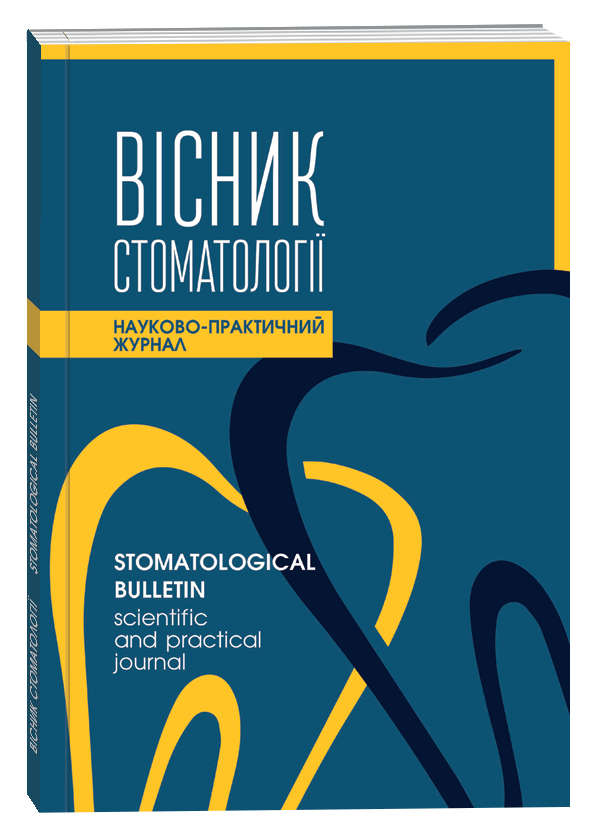BONE REGENERATION DURING ELIMINATION OF THE UPPER JAW ALVEOLAR PROCESS DEFECT IN RATS WITH AUTOTRANSPLANTS OF DIFFERENT ORIGIN AND DEGREE OF ITS FILLING
DOI:
https://doi.org/10.35220/2078-8916-2020-37-3-2-10Keywords:
histological study, rats, autograft, bone graft-ing, reparative regeneration, osteogenesisAbstract
The article presents the results of the study of reparative regeneration and the course of osteogenesis in autografts of different origin after elimination of the bone defect of the alveolar process of maxilla of 60 rats with different degrees of its filling. In 2018-2019 on the territory of the Experimental Biological Clinic of Bogomolets National Medical University Ukraine, Kyiv, a group of scientists: Professor L. M. Yakovenko, graduate student M. O. Kulynych, intern O. O. Kulynych performed an experi-mental study on 60 white rats; histology and morphometry were performed in the National Institute of Surgery and Transplantology named after O. O. Shalimov of National Academy of Medical Sciences of Ukraine by Ph.D. histologist I. M. Savytska. The animals were divid-ed into two groups of 30 animals each: the first group had a complete filling of the defect of the alveolar process of maxilla with an autograft, the second one had ½. Each group was divided into two subgroups. In the first sub-group, the defect of the alveolar process of maxilla was filled with osteoplastic material taken from the tibia, in the second subgroup, it was filled with osteoplastic mate-rial taken from the submaxilla. The animals were re-moved from the experiment on the 60th, 90th, and 120th days after the surgery. Reparative regeneration in the im-plantation zone occurred more intensively in the group with the ½ filling of the bone defect. This is evidenced by the consolidation, fusion of the submaxilla autograft with the surrounding bone tissue, and the completion of the process of osteoregeneration on the 60th day. Reparative regeneration and the course of osteogenesis are more complete with the use of the submaxilla autografts. It was found that the replacement of connective tissue and the formation of bone tissue in the area of the defect is com-pleted faster when the defect is filled to ½. This method of filling can be recommended for use in clinical settings.
References
Альфаро Ф.Э. Костная пластика в стоматологиче-ской имплантологии. Описание методик и их клиническое применение / Ф.Э. Альфаро; издатель А. Островский; пер. Е. Ханин, Р. Кононов. – М.: Азбука, 2006. – 235 с.
Белоус А.М. Некоторые итоги исследований по репаративной регенерации кости / А.М. Белоус, Е.Я. Панков // Механизмы регенерации костной ткани. – М.: Медицина, 2002. – С. 284 - 294.
Денисов С.Д. Требования к научным експеримен-там с использованием животных / С.Д. Денисов, Т.С. Мо-розкина // Здравоохранение. – 2001. – № 4. – С. 40 - 42.
Эйзенбраун О.В. Сравнительный анализ реконст-руктивных операций альвеолярной кости традиционным методом и туннельным методом костной пластики / О.В. Эйзенбраун, С.В. Тарасенко // Журнал научных статей «Здоровье и образование в XXI веке». – М.: Сообщество молодых врачей и организаторов здравоохранения. – 2013. – Т. 15, № 1-4. – С. 24-26.
Кулаков А.А. Хирургические методы реабилита-ции пациентов с выраженной костной атрофией верхней и нижней челюстей / А.А. Кулаков, М.А. Амхадова, В.М. Ко-ролев // Пародонтология. – 2006. – № 1. – С. 67-70.
Параскевич В.Л. Использование монокортикаль-ных аутотрансплантатов для наращивания высоты костной ткани в области дна верхнечелюстной пазухи / В.Л. Пара-скевич // Институт Стоматологии. – 2001. – № 3. – С. 35 - 40.
Скулеан А. Биоматериалы для реконструктивного лечения внутри костных пародонтальных дефектов. Часть I. Костные материалы и заменители кости / А. Скулеан, С. Йепсен; пер. А. Островский // ПЕРИО Ай Кью. – 2005. –
Вып. 1. – С. 21-32.
Early secondary bone grafting of alveolar cleft defects: A comparison between chinandrib grafts / W.A. Borstlap, K.L.W.M. Heidbuchel, H.P.M. Freihofer [et al.]. // J. Cranio Maxillo fac. Surg. – 1990. – Vol. 18. – P. 210-215.
Proussaefs P. The use of intra orally harvested autogenous block grafts for vertical alveolar ridge augmentation: A human study / P. Proussaefs, J. Lozada // Int. J. Periodontics Restorative Dent. – 2005. – Vol. 25. – P. 351-363.
The negativeeffectofcombining rhbmp-2 and bio-osson bone formation for maxillary sinus augmentation / Kao D.W.K., Kubota A., Nevins M. [et al.].// Int. J. Periodontic sRestorative Dent. – 2012. – Vol. 32. – P. 61-67.
Lamano Carvalho T. Histometri canalysis of rat al-veolar wound healing / Lamano Carvalho T, K. Bombonato, L. Brentegani // BrazDent J. – 1997. – №8. – P. 9-12.
Lamano Carvalho T. Histologic and histometric evalu-ation of rat alveolar wound healing around polyurethaneresin implants / Lamano Carvalho T., J. Teofilo, C. Araujo, L. Brentegani // Int J Oral Maxillofac Surg. – 1997. – №26. – P.149-152.
Mitogenic, chemotactic, and syntheticresponsesofrat periodontal ligament fibrobrolastic cell topolypepti degrowth factorsin vitro / N. Matsuda, W. Lin, N. Kumar [et al.] // J Periodontol. –1992. – №63. – Р. 515-525.
Polyurethane derived from Ricinus Communis as graft for bone defect treatments / SOUSA, Tatiana PeixotoTellesde [et al.] // Polímeros [online]. – 2018, №3(28). – P.246-255. Epub June 28, 2018.
Kurien T. Bone graft substitutes currently available in orthopaedic practice: the evidence for their use / T. Kurien, R.G. Pearson, B.E. Scammell // Bone Jt. J. – 2013. – 95-b. – P. 583-597
Dimitriou R. Bone regeneration: current concepts and future directions / R. Dimitriou, E. Jones, D. McGonagle, P.V. Giannoudis // BMC Med. – 2011. – №9 – Р. 66
WenhaoWangab Kelvin. Bone grafts and bio-materials substitutes for bone defect repair: A review. / WenhaoWangab Kelvin ,W.K.Yeungab // Bioactive Materials. Volume 2, Issue 4, December 2017, Pages 224- 247.
The biology of bone grafting / S.N. Khan, F.P. Cammisa, H.S. Sandhu [et al.] // J Am AcadOrthop Surg. – 2005 Jan-Feb; – №13(1). – Р. 77-86.









